Rather than bore all you fine people with details about myself, I thought I might instead begin by talking about what I consider the pinnacle of the superhero stories of my lifetime, the run that defines my love of comic books: Grant Morrison's run on JLA. Giving some context, prior to JLA, I had never bought a comic that did not explicitly have Superman or Batman in the title. JLA changed all that, and for the first time, introduced my 11-year-old self to the concept of the DC Universe. Over the course of his 30-some issue run from 1996-2000, Grant Morrison not only brought DC's biggest characters back in the spotlight together, but also helped forge a new era for superhero comics, the effects of which are still being felt today.
One of the most obvious aspects of this run that is famous and memorable is Morrison’s use of the “Big 7,” or the icons of the DC Universe, brought together as one team for the first time in years. Superman. Batman. Wonder Woman. Flash. Green Lantern. Aquaman. Martian Manhunter. Those are the characters you want to see on a Justice League team, and after years of seeing the League populated by characters no kid could identify out of a lineup of one, Morrison knew that. The characters were the DC Universe equivalents of the Greek Pantheon, and once he established that core team, it became easier to branch out and bring in some of the lesser known heroes of the DC Universe.
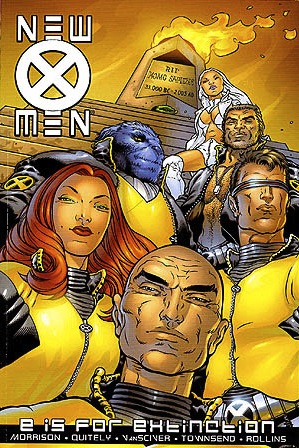 This is the kind of attitude that Morrison brought to Marvel during his run on New X-Men. He kept his team small with familiar characters like Professor X, Cyclops, Jean Grey, and Wolverine, then started adding new mutants and foes for them to face, while also updating a old foes as well. It makes it a much easier sell to new readers, hooking them with the characters they already know, then layering in the new stuff and continuity as you please.
This is the kind of attitude that Morrison brought to Marvel during his run on New X-Men. He kept his team small with familiar characters like Professor X, Cyclops, Jean Grey, and Wolverine, then started adding new mutants and foes for them to face, while also updating a old foes as well. It makes it a much easier sell to new readers, hooking them with the characters they already know, then layering in the new stuff and continuity as you please.
Brian Michael Bendis followed a similar suit when came to the Avengers franchise. No one was clamoring for a book about Spider-Woman, Luke Cage, and the Sentry, by building his team around Captain America and Iron Man and Spider-Man and Wolverine, Bendis had fans invested in the book already. People claimed Bendis was "JLA-ing the Avengers," but there's a reason: It works. From there he was able to build the franchise to Marvel's headliner; where stories spin out of there and help dictate the shape of the Marvel Universe. Stories can flow back into the book, and Bendis makes adjustments in stride, whether Tony Stark has to come off the table for a year, or a new Captain America has stepped up to wield the shield.
That underlines one of the problems with James Robinson's current run on the Justice League. The team's most popular, and arguably only big gun, is Hal Jordan's Green Lantern. Otherwise, you have grown-up replacement characters like Dick Grayson's Batman, Mon-El filling in for Superman, and Donna Troy mixed with B and C-list characters like Green Arrow, Cyborg, Guardian, Atom Doctor Light and Starfire.
This is the difficulty the book has had since Brad Meltzer's run on the title; it is not able to forge ahead on its own as it has become the book that is informed by everything else that's happening around the DC Universe. Whether it's seeing villains shipped off to another planet, Superman leaving for New Krypton, or whatever reason is keeping Wonder Woman out of the book, JLA is more and more becoming a book of also-rans.
Once readers were comfortable Morrison's new JLA, he started adding young blood. The new Green Arrow, Connor Hawke and Aztek, a new character created with Mark Millar, were not necessarily obvious choices to add to the team, but later become an important pieces of the larger puzzle Morrison has built his run around. The big roster shakeup in the book’s second year expanded the team a further seven members to include New Gods Orion and Big Barda, Superman’s one-time replacement Steel, Batman’s partners Huntress and Oracle, fallen angel Zaurel, and the forever pliable detective Plastic Man. The growing team was reflective of the growing scale of the large epic story Morrison was telling with the JLA.
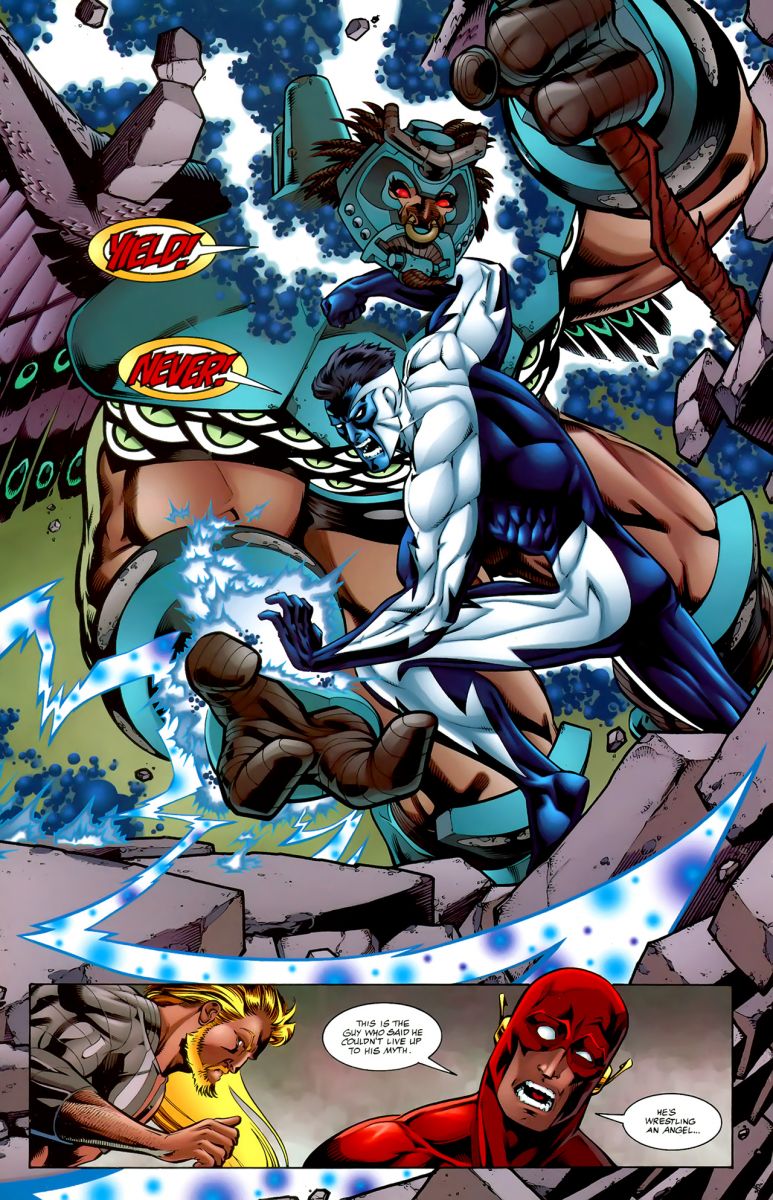 There is a real richness to JLA; it was adventurous, it was thought-provoking, it was exciting, and it was dense. White Martians. Heroic Androids. Renegade Angels. Psycho-Chemically Enhanced Former Coma Patients. The New Injustice Gang. Future Darkseid.Those are only some of the ideas Grant Morrison brought to the table in his first year on JLA.
There is a real richness to JLA; it was adventurous, it was thought-provoking, it was exciting, and it was dense. White Martians. Heroic Androids. Renegade Angels. Psycho-Chemically Enhanced Former Coma Patients. The New Injustice Gang. Future Darkseid.Those are only some of the ideas Grant Morrison brought to the table in his first year on JLA.
Morrison’s skill in weaving great interpersonal moments between characters throughout big action is a great part of what makes it so memorable. If all you see are one-note superheroes fighting bad guys, there’s nothing to grab onto. Conversely, if all you have is these same characters in spandex sitting around talking about their feelings and arguing, it will just as quickly grow tiresome. The big moments in the book are earned. Batman taking down White Martians with a match and some gasoline. Superman wrestling an angel. Green Arrow and the Atom defeating Darkseid with a trick arrow. The entire population of Earth gaining superpowers to defeat Maggedon. Moments like this were the payoff to character beats Morrison littered his run with, making them justifiably rewarding, and showing that this book knew what it was about.
There's something also to be said for the way Morrison paced and structured his stories on this title. In the years that followed, many books became reliant on nice 6-issue story arcs which would collect nicely into trade paperbacks. The problem is that kind of stoytelling eventually becomes stagnant; you expect an issue or two of setup, three isues of rising conflict, and then the crescendo. Morrison was able to tell fun and engaging stories in two, three and four issue arcs, so that when you saw a story that was part 1 of 6, you knew it was a big deal. When you realize that a 6-issue arc will run for half a year, you had better have a story that can support that kind of commitment, and not every story can or should. Bendis' first couple of years on New Avengers do not look altogether dissimilar, varying story arcs to fit the kind and tone of story he was telling.
Where other writers may have become bogged down in the ever-changing status quos of the team’s members, Morrison embraces the changes, weaving them into the grand tapestry of his epic run. From Superman's change to electricity-based powers, to Wonder Woman's mother stepping in for her momentarily-dead daughter, to the inability to use Hawkman due to continuity haywire, Morrison adjusted like a champ. Superman used his newfound powers better in the pages of JLA than in any of the solo Superman books. We saw a wiser, more determined Wonder Woman. In the absence of Hawkman, Morrison gave us Zauriel, the League’s first member on loan from Heaven. And in spite of that, it manages to avoid feel dated (maybe with the exception of Superman’s Super-Mullet in the first arc). In the same way he was able to make B and C-level characters shine alongside the icons, Morrison was able to take update and hokey or forgotten villains like the Key, Starro, and the Shaggy Man into far more dangerous foes than they had ever been. Rather than turn them into typical ‘90s clichés with extreme attitudes, big guns, and shoulder pads; rather Morrison found a way to make these characters genuinely frightening and intimidating by going back to their roots and figuring out what made. He figured out how these bad guys could get into the Leauge’s head and screw with them. He was able to use continuity without being bogged down by it, in much the same way I see Geoff Johns doing in his work now.
Morrison's love and deconstruction of Batman really began with JLA. One of the interesting themes that comes through when looking at Morrison’s JLA with a few years of hindsight is Bruce Wayne’s willingness to stand up to those far more powerful than himself. When this run was being released monthly, Morrison got some flack for his portrayal of Batman as a “Bat-God,” that idea he was the guy on the team with no powers, yet he commanded the respect and fear of those he faced as well as some of his team members. He always had a plan, and was always three steps ahead of everyone else, which is the beauty of the character, and Morrison really honed in on that aspect. In order to stand toe to toe with gods and war machines, Batman’s ego had to became his own superpower. The best example of this is beautifully illustrated in JLA #14 and Final Crisis #6, Batman faces a certain death, no-way-out scenario in the face of Darkseid, and in order to “win,” meets the business end of Darkseid’s Omega Beams. Morrison's Batman is the ultimate hardass; he's lived through every story told about Batman since the 1930s in the span of his one lifetime, and this is the effect it has on one man; he doesn't back down, not even to gods.
Standing shoulder to shoulder with the icons of the DC Universe was the recently-minted Green Lantern Kyle Rayner. Morrison took Rayner from a guy that not even Wally West liked and mumbled his words in team meetings, to a hero whose willpower contained an exploding tyrant sun and overcame a war machine of the gods. I would argue Kyle is the backbone of the title, and whose growth as a hero really defines the arc of the series.
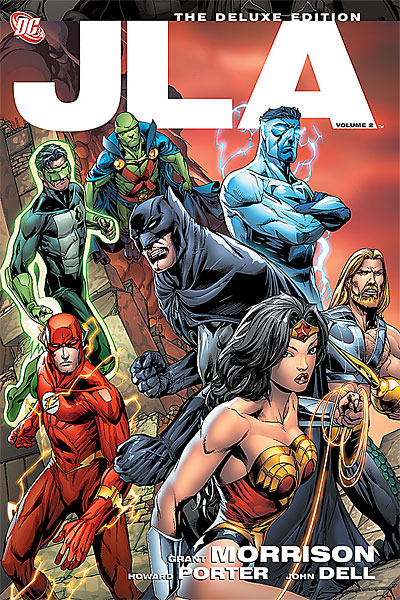 I must also mention lay some praise on Howard Porter, Morrison's artistic parter on JLA. His style was definitely one that took some getting used to, but now I honestly cannot imagine someone else having drawn that book. In the years since JLA, Porter's style has evolved and improved to the point that I would love to see him tackle the characters again. Given the constant state of flux the JLA title and team has been in for the past four or five years, I find myself wondering if Morrison and Porter could find their way home again, whether in the monthly comic, a mini-series, or even an original graphic novel. It seems clear that Morrison at least has a fondness for the characters and stories he explored during this run, as he has come back to this well in a number of his other works since then. Seven Soldiers of Victory, All-Star Superman, 52, Batman, Final Crisis; all books of his that owe some part of themselves to ideas started way back in JLA.
I must also mention lay some praise on Howard Porter, Morrison's artistic parter on JLA. His style was definitely one that took some getting used to, but now I honestly cannot imagine someone else having drawn that book. In the years since JLA, Porter's style has evolved and improved to the point that I would love to see him tackle the characters again. Given the constant state of flux the JLA title and team has been in for the past four or five years, I find myself wondering if Morrison and Porter could find their way home again, whether in the monthly comic, a mini-series, or even an original graphic novel. It seems clear that Morrison at least has a fondness for the characters and stories he explored during this run, as he has come back to this well in a number of his other works since then. Seven Soldiers of Victory, All-Star Superman, 52, Batman, Final Crisis; all books of his that owe some part of themselves to ideas started way back in JLA.
It is worth noting that DC is currently reprinting Morrison's entire run on JLA (including the Secret Files, JLA/WildC.A.T.S., Earth 2, and his JLA: Classified arc) in a fantastic series of four oversized Deluxe Edition hardcovers. Whether you have never read this run, or it has just been a long time since you've done so, I cannot recommend it highly enough. Also be sure to check out the iFanboy Video Show Spotlight on Grant Morrison for Josh, Conor, and Ron’s take on this seminal run.
Benjamin Simpson lives and works in Los Angeles, is more than willing to lend his name to commercial products and tries to cultivate a cult of personality through his little-read newsletters, fan club, and so on. Feel free to send him an email or follow him on Twitter.
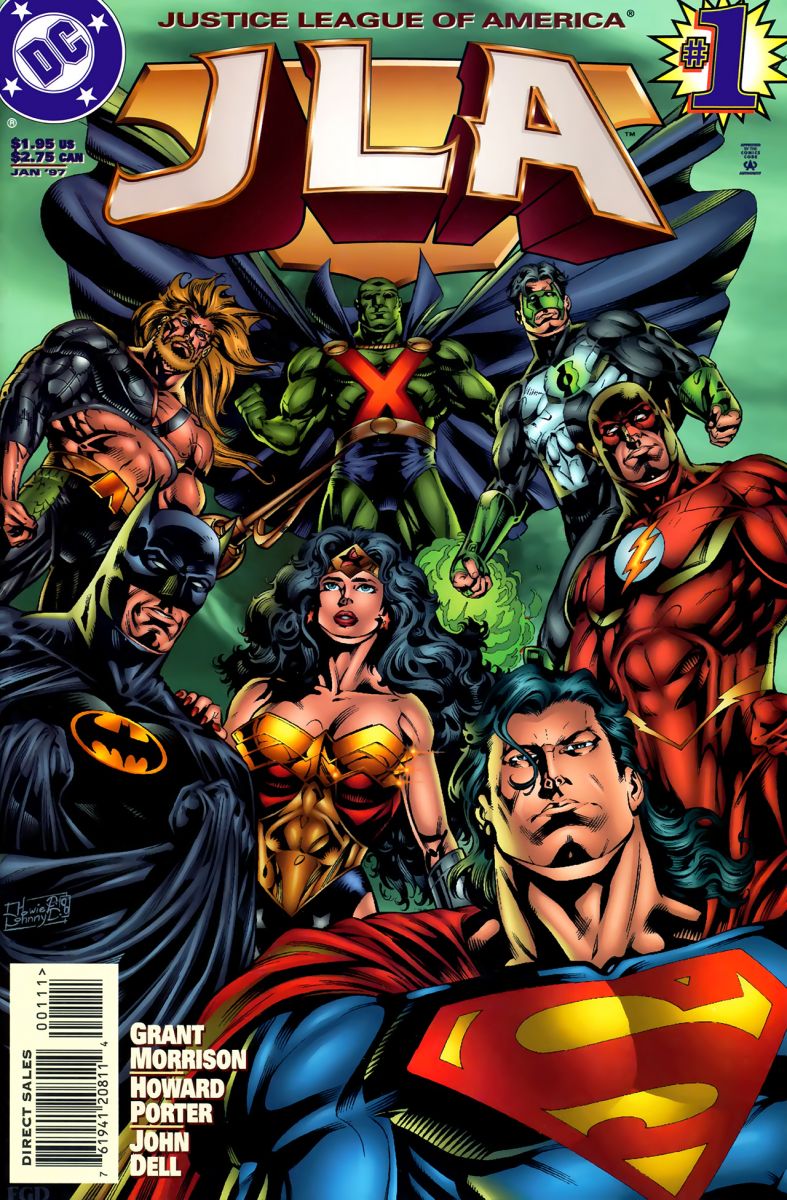
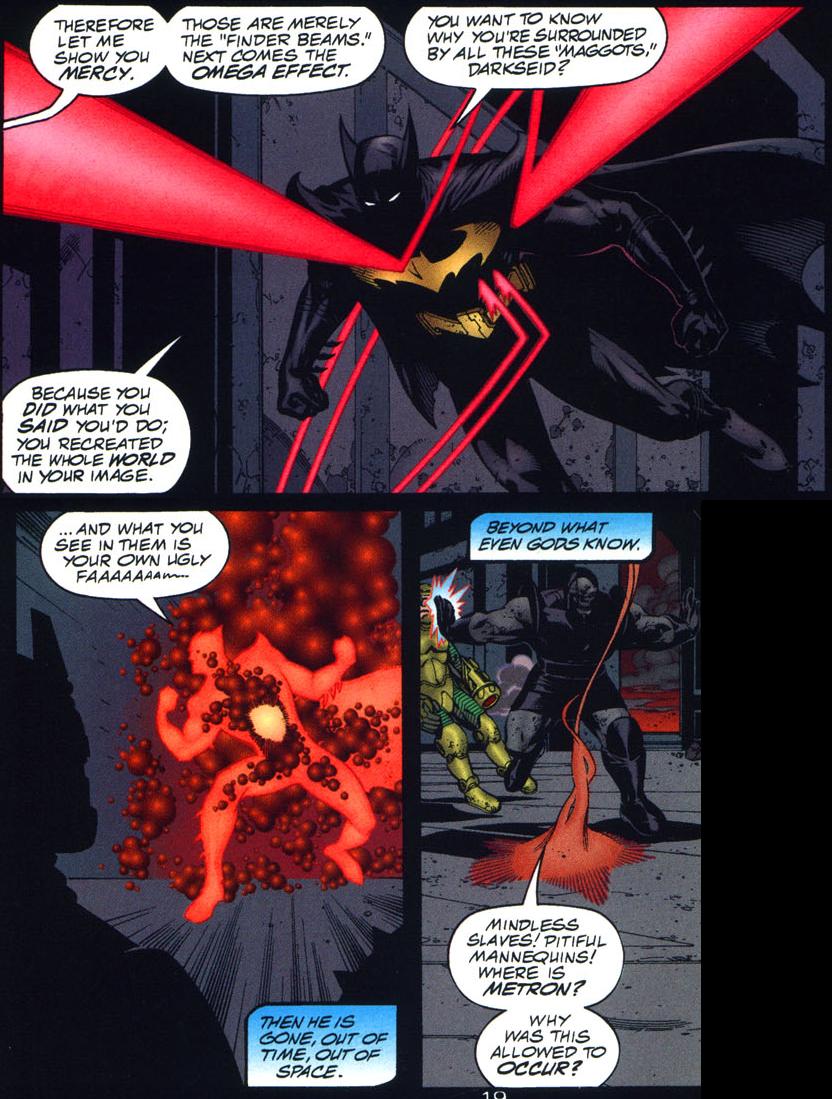
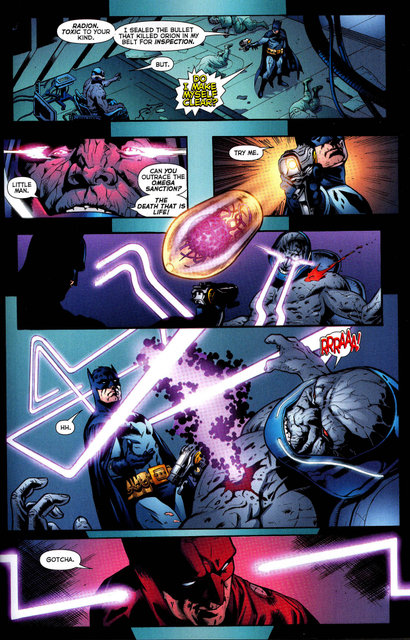


Great article! I recently re-read some of Morrison’s JLA run in preparation for the Batman & Robin trade, and I had forgotten some of its best components, all of which you have highlighted brilliantly here.
Awesome column. I finally got to read the Morrison run a year or two ago, just sat on the couch and devoured the whole thing like a big thanksgiving meal, and like a big thanksgiving meal is was satisfying and filling. I know I’m going to get those deluxe hardcovers soon (reading this article almost made me jump to Amazon now and get them.) This may be one of the best, if not THE best straight faced Justice League run, there’s a reason it is constantly talked about, and will continued to be so years from now.
Morrison’s JLA was one of the earliest comics I read. I consider myself very lucky in that regard.
Though, to this day, I am dissatisfied with how he rushed the first World War III. You don’t give the whole of humanity superpowers for three pages and not have them do anything. -_-
Yes. I love this run. I’ve been grabbing some out of the bargain bins and have gotten adicted. To me this is what comics should be. And you’ve really nailed the ‘why’. I think Robinson had a chance to do something really good by reestablishing the new JLA and developing the characters. Something like the 80’s JLI did after The Crisis. Thanks for the reminder that I need to go bin diving again.
Okay now I’ve heard enough praise on this book to at least pick up the first hardcover.
I’ve been wanting to read Morrison’s run on New X-Men for awhile now. I guess I should read his JLA too. More to add to the stack!
I recently started this run and have read upto Rock of Ages, and the Final Crisis comparison is rather apt, as both contain the same story. I prefer the "leaner" older version, for obvious reasons. Overall though JLA is quite brilliant. I will continue this run as time allows.
Morrison’s JLA run is one of the big books that brought be back to comics in the late 90’s after being disillusioned with comics altogether in the mid 90’s. This is how "epics" should be done and pretty much every story arc Morrison did during this run defined that.
Current JLA needs a reset badly and I think getting back to this kind of storytelling is what is going to get it back on track. It’s been bogged down way too much lately in DC crossover events.
Morrison’s run was fantastic. The deluxe editions look great, and I still don’t know why this isn’t ABSOLUTE. I guess that’s because its too many issues.
I don’t know how on Earth you could see traces of Geoff Johns doing something like this. His Green Lantern(and judging by Flash: Secret Files & Origins too) is filled with him picking and choosing aspects of IN CONTINUITY stories that he likes. Grant Morrison has time and time again made it his business to bring in more continuity, where as Johns seems to throw out whatever doesn’t sound like the idealistic Hal Jordan he has in his mind.
But focusing on JLA, its amazing all the way through. And I definitely agree that Kyle Rayner was the backbone of this saga. Every time he shows up in WW3 is a great moment.
I have been reading this in the deluxe HCs that DC has been reprinting. It’s amazing superhero comics, and I have a blast with each volume. I believe the third one hits at the end of this month, so I can’t wait!
That was a great read. Just got the second volume a week ago and really loved it.
I haven’t read Morrison’s JLA yet, though it’s quite high on my to-do list. I totally agree with your views on his Batman, though, as these aspects are pretty aparent in his solo series. I’m looking forward to reading JLA at sometime in the future.
This run is nearly un-readable by today’s standards and completely inaccessible to new readers.
@KickAss-As always, you’re completely wrong on both counts.
@KickAss – I respectfully disagree. I did not read this run when it originally came out. I read it for the first time roughly two years ago (soon after I got back into comics) and loved every page of it. I had very little trouble understanding what was going on despite having very little knowledge of the characters.
Comics super hero insanity at it’s finest- best moment ….. The paraplegic download !!!
I rather liked this Bejamin Simpson fellow
A friend asked me to read these in 1999 because he wanted me to get back into comics. I know I’m wrong, but I didn’t care for it either. It was … OK at best. I picked up the pre-Deluxe Edition trades at Half-Price Books in 2007; still did nothing for me. Perhaps it’s my Marvel bias kicking in, I dunno.
And as someone who had sat out 1985-1999, it was pretty incomprehensible as well. Blue Superman? Wally is Flash? Kyle who?
Perhaps it’s my Marvel bias kicking in, I dunno. This was, however, a nice article on it and its influence. Welcome to the iFanboy fold.
Welcome to the site Benjamin and I just have to say that Morrisons run on JLA was actually the thing that brought me back to reading comics and introduced me to the DCU. That scene with Supes wrestling with the angel gets me everytime it is brilliant.
@Rob-You’re not the only one. There’s tons that agree with you.
I read these in trade when I was twelve and they were the greatest thing I ever read. Incomprehensable my ass.
Oh, and great article! I’m looking forward to more of your stuff Benjamin.
Great article. I love that run of JLA and hope the series gets back to that level of quality
I was gonna disagree about the use of the big 7 automatically equalling greatness, but that idea of instant recognition to draw them people makes a lot of sense. obviously you have to have a good writer too, knowing what’s going on and maybe jla needs to move to it’s own pocket universe or something. but i also like seeing the b-list guys on the team for a little exposure. i loved seeing booster gold and blue beetle alongside bats and j’onn. i liked learning about red tornado with meltzer.
And yeah, electro superman was probably lame but has anyone gone back and read those stories?People dismiss out of hand as one in another line of fads but are they doing it as a knee-jerk reaction to the changes to an iconic character or is the story actually bad? I really enjoyed superman throughout the 90s. i loved the week to week schedule and seeing supes having to master a whole set of new powers, whilst dealing with the fact that when he wasn’t using them he’d become human. it was interesting to see this confident guy approach this, worried but knowing he would still try to be the best hero he could be. and it brought one of my favourite issues, the death of mxyzptlk, one of the funniest issues i’ve read. it was a nice little change for about a year and then it was over.
The: X-men, Batman and Superman TV series are the shows that raised me as a child. So when I was old enough to actually start purchasing comics on my own, This was the first couple of trades I purchased. I love this story. my 2 favorite superhero books are Morrison’s run on JLA and Joe Kelly’s run on JLA Elite.
I recently bought the 1st volume HC (I do have the original issues), and thought it held up fairly well but was dated in parts, Supes electric look, and even the Hitman appearance, hilarious as it still is. It also made me sad for the current state of affairs of the JLA book, even though the last few issues seem to be showing signs of life. But a few issues can’t make up for 3 years of mediocre comics on the flagship book.
Excellent taste, Benjamin, and I agree wholeheartedly. This series pretty much got me on board DC as well after years of false starts.
Morrison’s run on JLA is one of those runs (along with his run on New X-Men and Johns’ original run on Flash) that I’m proud to say I read in monthly issues. JLA has not even neared this level of greatness since (in my opinion). With the resurrections in Blackest Night over and done with, we’re one step closer to a Big 7 JLA. Mr. Simpson did a stellar job of explaining why it works so well, so I’m not gonna reitterate. I’ll just say that any other roster is sub-par, and if Robinson doesn’t shape up by the end of the year, let’s get someone on the book who can return it to it’s former glory.
Dude that was one hell of a breakdown. Got me all excited to pick up the other 3 deluxe editions i do not own.
When these were coming out my interest in the DCU was limited strictly to the bat books but I kept hearing good things about this JLA run and so I started picking it up around issue 7. It never stopped after that. I didn’t have any trouble picking up what Morrison was putting down. I’m more of a Marvel guy at times but I will take this run over the X-Men run any day.